Legal and Ethical Principles in Healthcare: A Case Study Report
VerifiedAdded on 2022/09/14
|12
|3518
|324
Report
AI Summary
This report analyzes a case study involving Doreen, an inmate in a Queensland Correctional Facility, and the application of legal and ethical principles in healthcare. It examines the values of personal responsibility and accountability, and their impact on decision-making, particularly concerning advance health directives (AHDs). The report discusses the consistency of decisions made by healthcare providers with the Universal Declaration on Bioethics and Human Rights, specifically Articles 5 and 7, regarding patient autonomy, individual responsibility, and the treatment of persons without consent. It explores legal obligations related to obtaining consent for medical procedures like tracheostomy and pacemaker insertion, considering the legal authority of various stakeholders, including the prison governor and Doreen's friend, Bea. The report also addresses the assessment of Doreen's decision-making capacity and the validity of her AHD in refusing CPR, providing a detailed analysis of the legal and ethical considerations involved in the scenario.
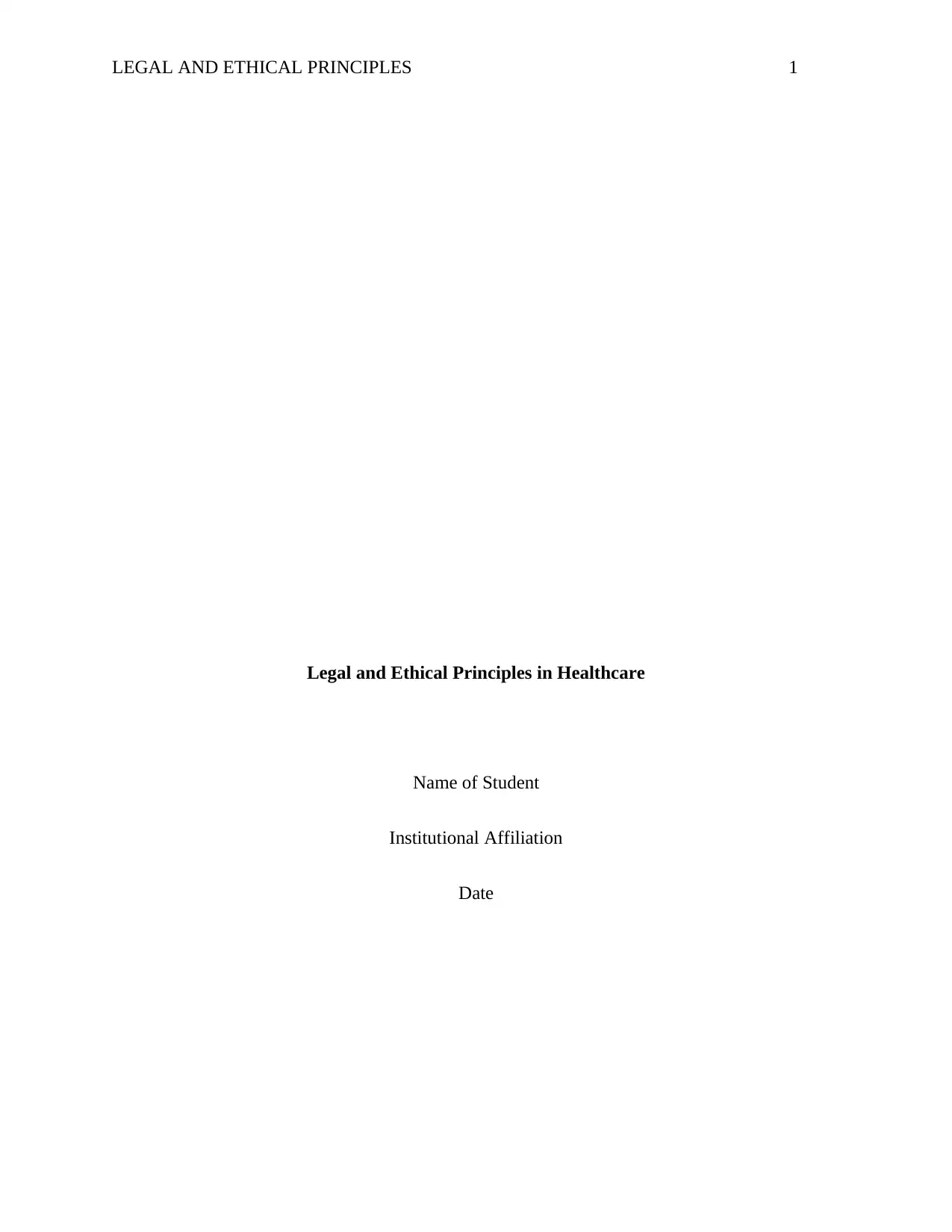
LEGAL AND ETHICAL PRINCIPLES 1
Legal and Ethical Principles in Healthcare
Name of Student
Institutional Affiliation
Date
Legal and Ethical Principles in Healthcare
Name of Student
Institutional Affiliation
Date
Paraphrase This Document
Need a fresh take? Get an instant paraphrase of this document with our AI Paraphraser
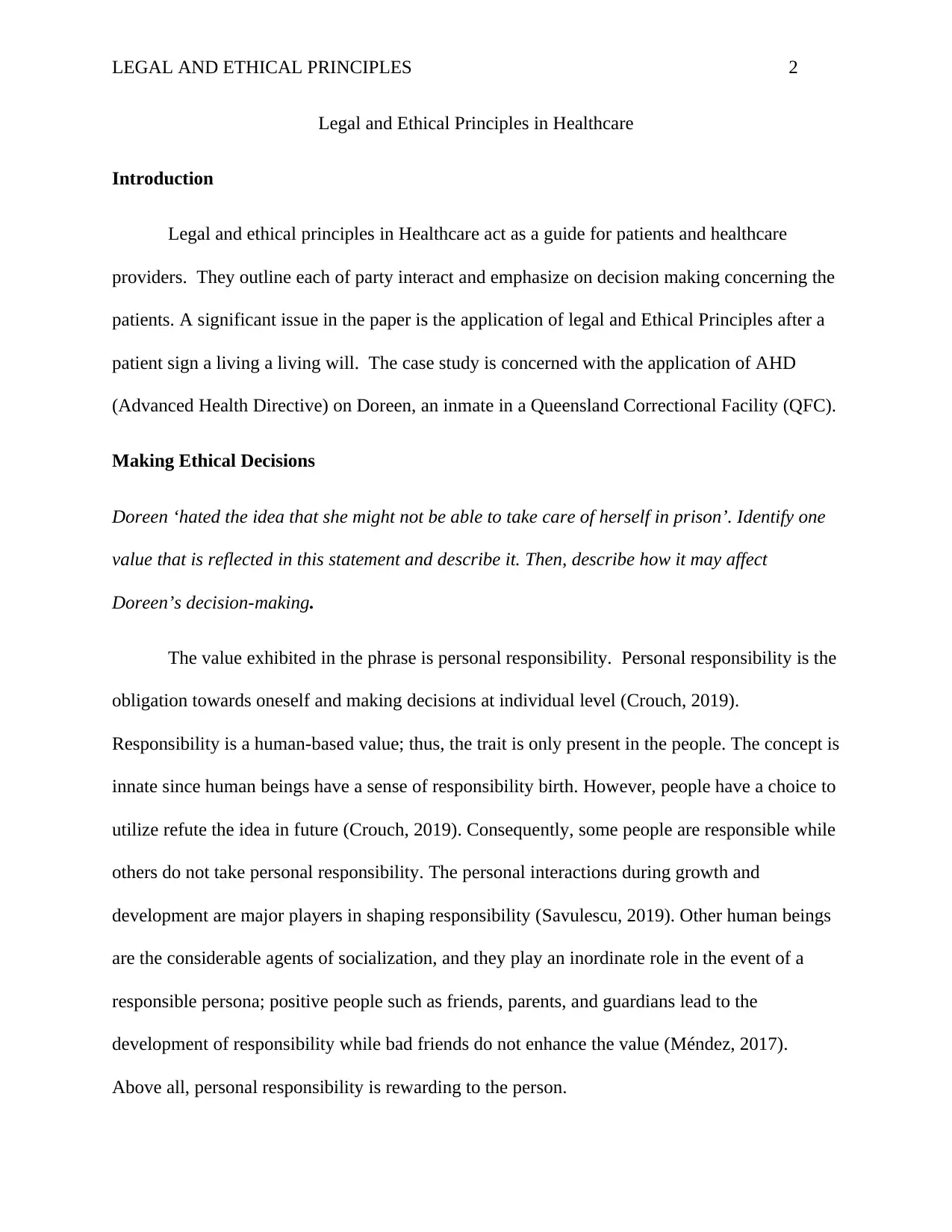
LEGAL AND ETHICAL PRINCIPLES 2
Legal and Ethical Principles in Healthcare
Introduction
Legal and ethical principles in Healthcare act as a guide for patients and healthcare
providers. They outline each of party interact and emphasize on decision making concerning the
patients. A significant issue in the paper is the application of legal and Ethical Principles after a
patient sign a living a living will. The case study is concerned with the application of AHD
(Advanced Health Directive) on Doreen, an inmate in a Queensland Correctional Facility (QFC).
Making Ethical Decisions
Doreen ‘hated the idea that she might not be able to take care of herself in prison’. Identify one
value that is reflected in this statement and describe it. Then, describe how it may affect
Doreen’s decision-making.
The value exhibited in the phrase is personal responsibility. Personal responsibility is the
obligation towards oneself and making decisions at individual level (Crouch, 2019).
Responsibility is a human-based value; thus, the trait is only present in the people. The concept is
innate since human beings have a sense of responsibility birth. However, people have a choice to
utilize refute the idea in future (Crouch, 2019). Consequently, some people are responsible while
others do not take personal responsibility. The personal interactions during growth and
development are major players in shaping responsibility (Savulescu, 2019). Other human beings
are the considerable agents of socialization, and they play an inordinate role in the event of a
responsible persona; positive people such as friends, parents, and guardians lead to the
development of responsibility while bad friends do not enhance the value (Méndez, 2017).
Above all, personal responsibility is rewarding to the person.
Legal and Ethical Principles in Healthcare
Introduction
Legal and ethical principles in Healthcare act as a guide for patients and healthcare
providers. They outline each of party interact and emphasize on decision making concerning the
patients. A significant issue in the paper is the application of legal and Ethical Principles after a
patient sign a living a living will. The case study is concerned with the application of AHD
(Advanced Health Directive) on Doreen, an inmate in a Queensland Correctional Facility (QFC).
Making Ethical Decisions
Doreen ‘hated the idea that she might not be able to take care of herself in prison’. Identify one
value that is reflected in this statement and describe it. Then, describe how it may affect
Doreen’s decision-making.
The value exhibited in the phrase is personal responsibility. Personal responsibility is the
obligation towards oneself and making decisions at individual level (Crouch, 2019).
Responsibility is a human-based value; thus, the trait is only present in the people. The concept is
innate since human beings have a sense of responsibility birth. However, people have a choice to
utilize refute the idea in future (Crouch, 2019). Consequently, some people are responsible while
others do not take personal responsibility. The personal interactions during growth and
development are major players in shaping responsibility (Savulescu, 2019). Other human beings
are the considerable agents of socialization, and they play an inordinate role in the event of a
responsible persona; positive people such as friends, parents, and guardians lead to the
development of responsibility while bad friends do not enhance the value (Méndez, 2017).
Above all, personal responsibility is rewarding to the person.

LEGAL AND ETHICAL PRINCIPLES 3
In the case study, Doreen feels it’s obligatory for her to take care of herself, and it affects
her living will. Doreen cares about her health and believes that she is liable to take care of herself
in the future. Therefore, the value becomes consequential in her healthcare decision. Due to her
advanced age and health condition, the prison facility requires her to sign an advance health
directive (AHD). AHD is a document signed by older people or those diagnosed with terminal
diseases about their future medical decisions. Due to personal responsibility, Personal
responsibility pushes, Doreen prefer dying rather than staying alive if she cannot take care of
herself.
Bea ‘wants everything possible to be done to get her [Doreen] better’. Identify one value that is
reflected in this statement and describe it. Then, describe how it may affect Bea’s decision-
making in relation to Doreen.
Bea’s words show the value of accountability. Accountability is taking charge of other
people’s affairs or organizations as if they were your own. Like any other value, personal
interactions play a great role in development of accountability (Karlsson-Vinkhuyzen, Dahl, &
Persson, 2018). People may be accountable to themselves but not to others. Developing
accountability to other people comes alongside other virtues such a love, interpersonal
relationship, and loyalty. In such a case, the persons developing accountability for others must
commit themselves the organization or the persons. Liability cannot be delegated, and the person
must agree to be accountable (Karlsson-Vinkhuyzen et al., 2018). Accountability makes a sharp
difference between success and failure; when people are responsible for others, there is increased
wellbeing of others.
Bea is accountable for Doreen since they are close friends while in the facility. Bea
assumes Doreen’s life as her own. She feels that healthcare providers should do anything
In the case study, Doreen feels it’s obligatory for her to take care of herself, and it affects
her living will. Doreen cares about her health and believes that she is liable to take care of herself
in the future. Therefore, the value becomes consequential in her healthcare decision. Due to her
advanced age and health condition, the prison facility requires her to sign an advance health
directive (AHD). AHD is a document signed by older people or those diagnosed with terminal
diseases about their future medical decisions. Due to personal responsibility, Personal
responsibility pushes, Doreen prefer dying rather than staying alive if she cannot take care of
herself.
Bea ‘wants everything possible to be done to get her [Doreen] better’. Identify one value that is
reflected in this statement and describe it. Then, describe how it may affect Bea’s decision-
making in relation to Doreen.
Bea’s words show the value of accountability. Accountability is taking charge of other
people’s affairs or organizations as if they were your own. Like any other value, personal
interactions play a great role in development of accountability (Karlsson-Vinkhuyzen, Dahl, &
Persson, 2018). People may be accountable to themselves but not to others. Developing
accountability to other people comes alongside other virtues such a love, interpersonal
relationship, and loyalty. In such a case, the persons developing accountability for others must
commit themselves the organization or the persons. Liability cannot be delegated, and the person
must agree to be accountable (Karlsson-Vinkhuyzen et al., 2018). Accountability makes a sharp
difference between success and failure; when people are responsible for others, there is increased
wellbeing of others.
Bea is accountable for Doreen since they are close friends while in the facility. Bea
assumes Doreen’s life as her own. She feels that healthcare providers should do anything
⊘ This is a preview!⊘
Do you want full access?
Subscribe today to unlock all pages.

Trusted by 1+ million students worldwide
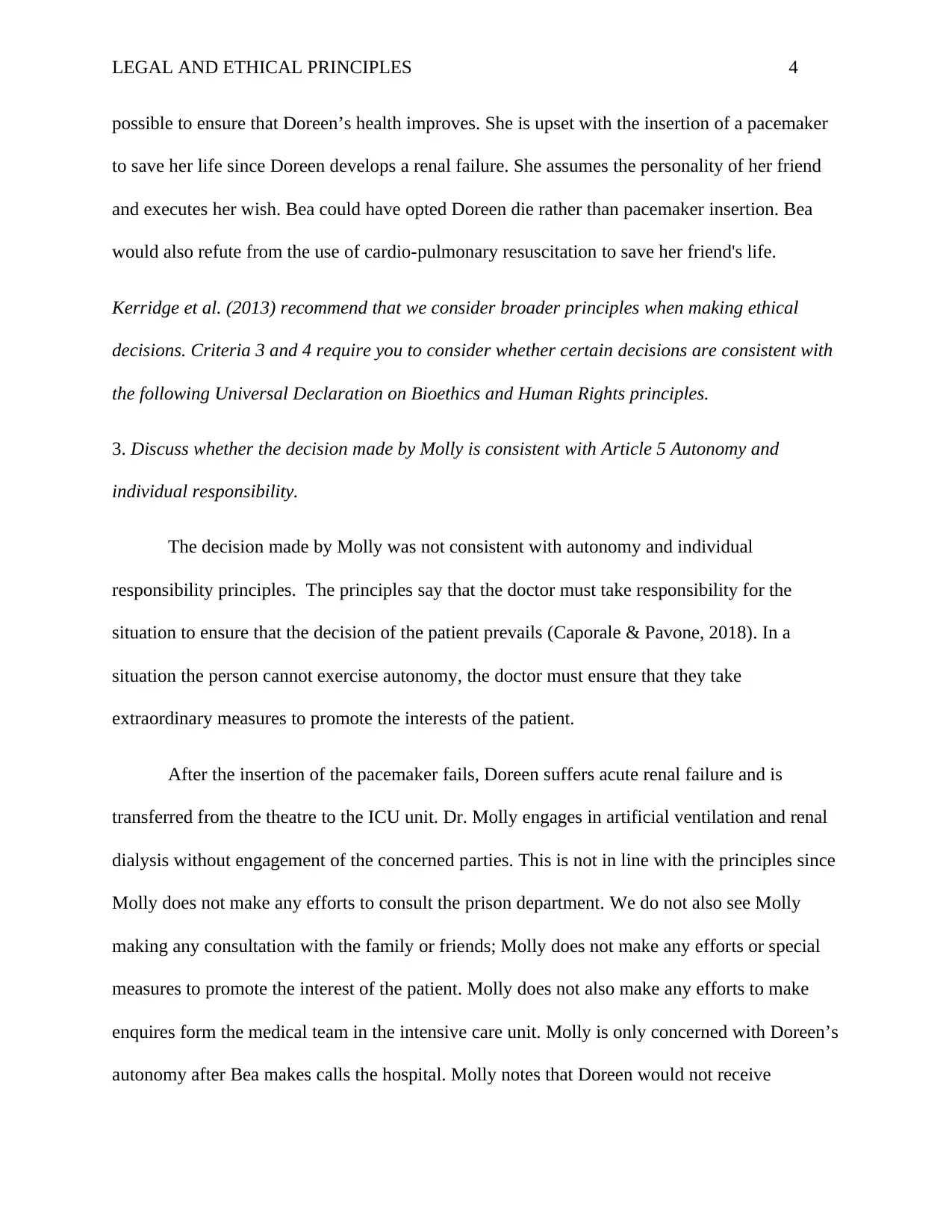
LEGAL AND ETHICAL PRINCIPLES 4
possible to ensure that Doreen’s health improves. She is upset with the insertion of a pacemaker
to save her life since Doreen develops a renal failure. She assumes the personality of her friend
and executes her wish. Bea could have opted Doreen die rather than pacemaker insertion. Bea
would also refute from the use of cardio-pulmonary resuscitation to save her friend's life.
Kerridge et al. (2013) recommend that we consider broader principles when making ethical
decisions. Criteria 3 and 4 require you to consider whether certain decisions are consistent with
the following Universal Declaration on Bioethics and Human Rights principles.
3. Discuss whether the decision made by Molly is consistent with Article 5 Autonomy and
individual responsibility.
The decision made by Molly was not consistent with autonomy and individual
responsibility principles. The principles say that the doctor must take responsibility for the
situation to ensure that the decision of the patient prevails (Caporale & Pavone, 2018). In a
situation the person cannot exercise autonomy, the doctor must ensure that they take
extraordinary measures to promote the interests of the patient.
After the insertion of the pacemaker fails, Doreen suffers acute renal failure and is
transferred from the theatre to the ICU unit. Dr. Molly engages in artificial ventilation and renal
dialysis without engagement of the concerned parties. This is not in line with the principles since
Molly does not make any efforts to consult the prison department. We do not also see Molly
making any consultation with the family or friends; Molly does not make any efforts or special
measures to promote the interest of the patient. Molly does not also make any efforts to make
enquires form the medical team in the intensive care unit. Molly is only concerned with Doreen’s
autonomy after Bea makes calls the hospital. Molly notes that Doreen would not receive
possible to ensure that Doreen’s health improves. She is upset with the insertion of a pacemaker
to save her life since Doreen develops a renal failure. She assumes the personality of her friend
and executes her wish. Bea could have opted Doreen die rather than pacemaker insertion. Bea
would also refute from the use of cardio-pulmonary resuscitation to save her friend's life.
Kerridge et al. (2013) recommend that we consider broader principles when making ethical
decisions. Criteria 3 and 4 require you to consider whether certain decisions are consistent with
the following Universal Declaration on Bioethics and Human Rights principles.
3. Discuss whether the decision made by Molly is consistent with Article 5 Autonomy and
individual responsibility.
The decision made by Molly was not consistent with autonomy and individual
responsibility principles. The principles say that the doctor must take responsibility for the
situation to ensure that the decision of the patient prevails (Caporale & Pavone, 2018). In a
situation the person cannot exercise autonomy, the doctor must ensure that they take
extraordinary measures to promote the interests of the patient.
After the insertion of the pacemaker fails, Doreen suffers acute renal failure and is
transferred from the theatre to the ICU unit. Dr. Molly engages in artificial ventilation and renal
dialysis without engagement of the concerned parties. This is not in line with the principles since
Molly does not make any efforts to consult the prison department. We do not also see Molly
making any consultation with the family or friends; Molly does not make any efforts or special
measures to promote the interest of the patient. Molly does not also make any efforts to make
enquires form the medical team in the intensive care unit. Molly is only concerned with Doreen’s
autonomy after Bea makes calls the hospital. Molly notes that Doreen would not receive
Paraphrase This Document
Need a fresh take? Get an instant paraphrase of this document with our AI Paraphraser
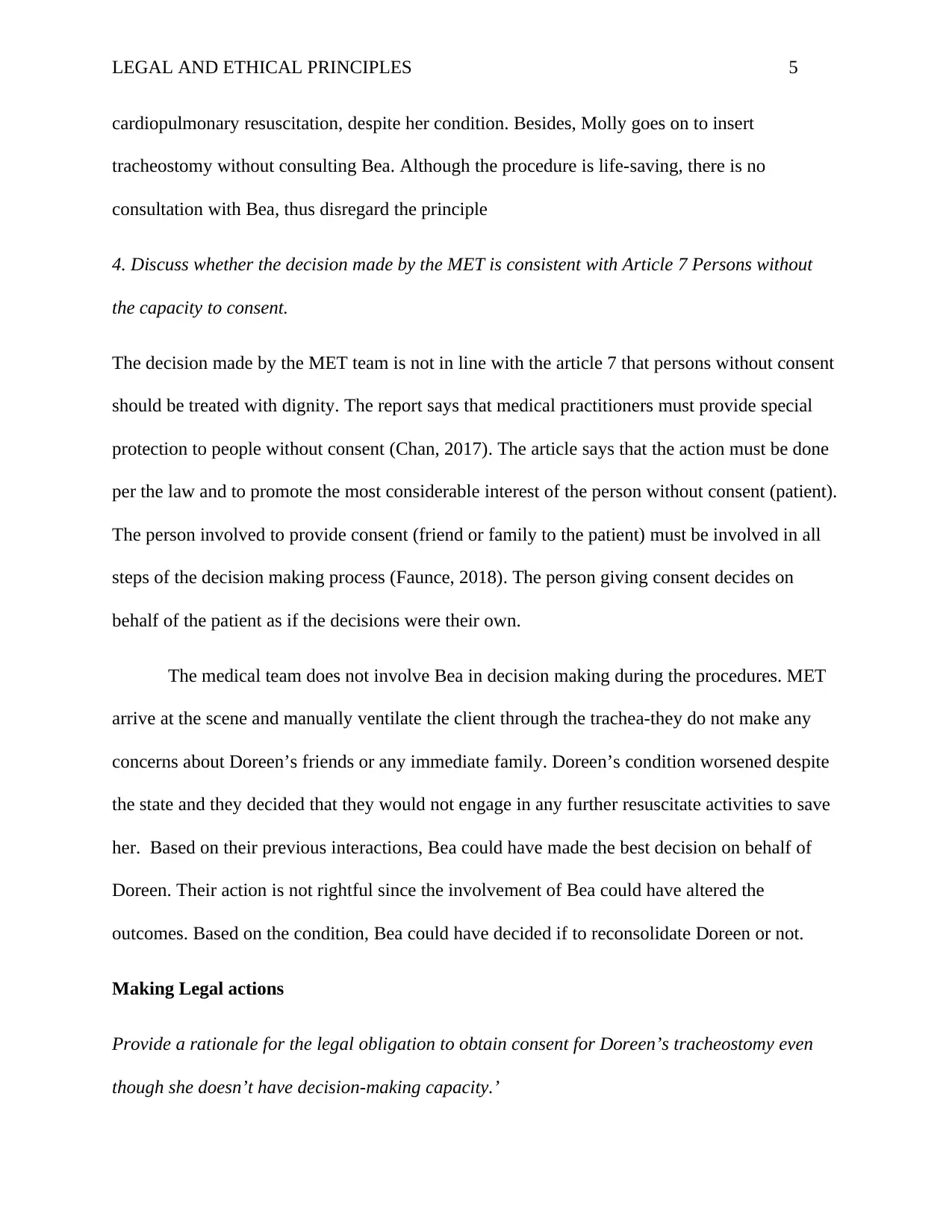
LEGAL AND ETHICAL PRINCIPLES 5
cardiopulmonary resuscitation, despite her condition. Besides, Molly goes on to insert
tracheostomy without consulting Bea. Although the procedure is life-saving, there is no
consultation with Bea, thus disregard the principle
4. Discuss whether the decision made by the MET is consistent with Article 7 Persons without
the capacity to consent.
The decision made by the MET team is not in line with the article 7 that persons without consent
should be treated with dignity. The report says that medical practitioners must provide special
protection to people without consent (Chan, 2017). The article says that the action must be done
per the law and to promote the most considerable interest of the person without consent (patient).
The person involved to provide consent (friend or family to the patient) must be involved in all
steps of the decision making process (Faunce, 2018). The person giving consent decides on
behalf of the patient as if the decisions were their own.
The medical team does not involve Bea in decision making during the procedures. MET
arrive at the scene and manually ventilate the client through the trachea-they do not make any
concerns about Doreen’s friends or any immediate family. Doreen’s condition worsened despite
the state and they decided that they would not engage in any further resuscitate activities to save
her. Based on their previous interactions, Bea could have made the best decision on behalf of
Doreen. Their action is not rightful since the involvement of Bea could have altered the
outcomes. Based on the condition, Bea could have decided if to reconsolidate Doreen or not.
Making Legal actions
Provide a rationale for the legal obligation to obtain consent for Doreen’s tracheostomy even
though she doesn’t have decision-making capacity.’
cardiopulmonary resuscitation, despite her condition. Besides, Molly goes on to insert
tracheostomy without consulting Bea. Although the procedure is life-saving, there is no
consultation with Bea, thus disregard the principle
4. Discuss whether the decision made by the MET is consistent with Article 7 Persons without
the capacity to consent.
The decision made by the MET team is not in line with the article 7 that persons without consent
should be treated with dignity. The report says that medical practitioners must provide special
protection to people without consent (Chan, 2017). The article says that the action must be done
per the law and to promote the most considerable interest of the person without consent (patient).
The person involved to provide consent (friend or family to the patient) must be involved in all
steps of the decision making process (Faunce, 2018). The person giving consent decides on
behalf of the patient as if the decisions were their own.
The medical team does not involve Bea in decision making during the procedures. MET
arrive at the scene and manually ventilate the client through the trachea-they do not make any
concerns about Doreen’s friends or any immediate family. Doreen’s condition worsened despite
the state and they decided that they would not engage in any further resuscitate activities to save
her. Based on their previous interactions, Bea could have made the best decision on behalf of
Doreen. Their action is not rightful since the involvement of Bea could have altered the
outcomes. Based on the condition, Bea could have decided if to reconsolidate Doreen or not.
Making Legal actions
Provide a rationale for the legal obligation to obtain consent for Doreen’s tracheostomy even
though she doesn’t have decision-making capacity.’
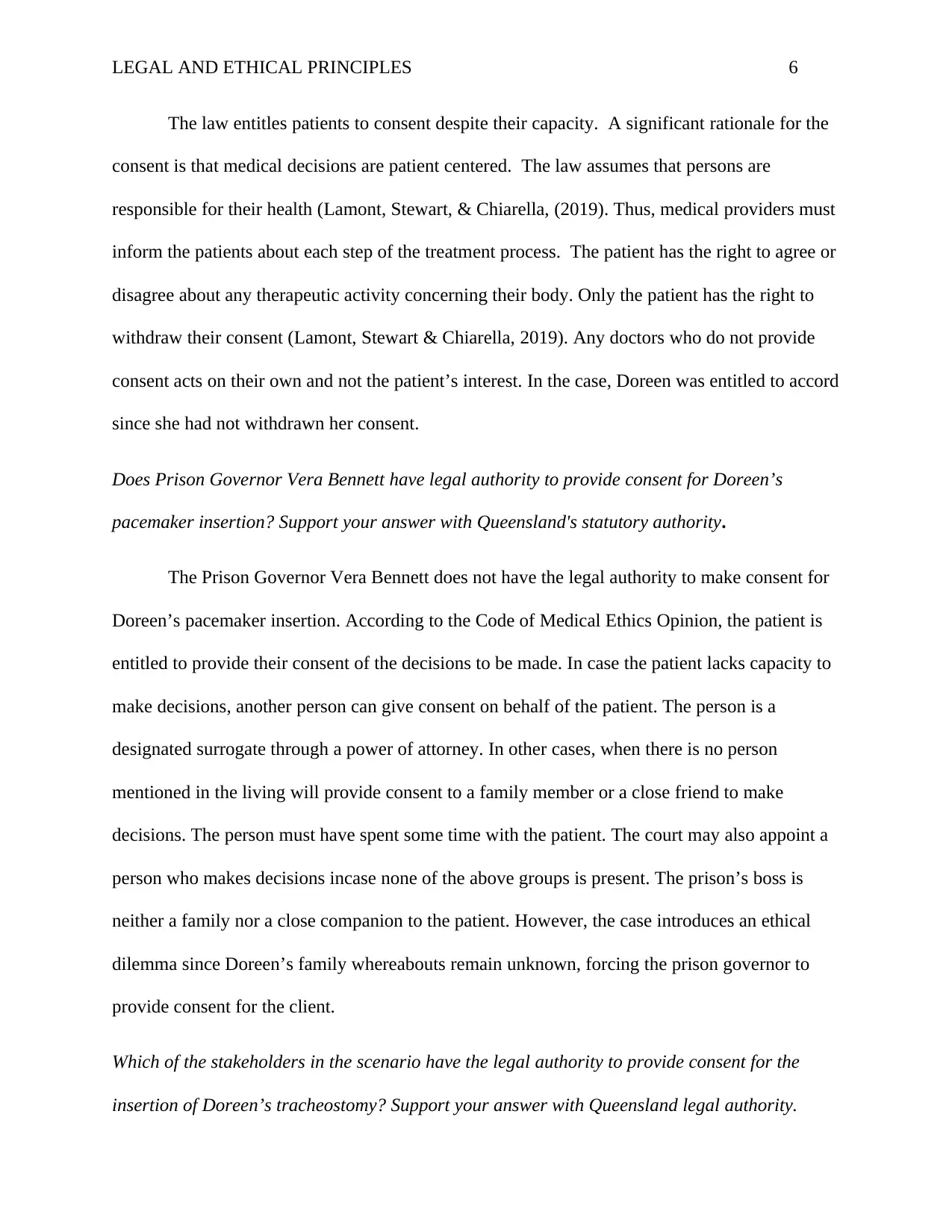
LEGAL AND ETHICAL PRINCIPLES 6
The law entitles patients to consent despite their capacity. A significant rationale for the
consent is that medical decisions are patient centered. The law assumes that persons are
responsible for their health (Lamont, Stewart, & Chiarella, (2019). Thus, medical providers must
inform the patients about each step of the treatment process. The patient has the right to agree or
disagree about any therapeutic activity concerning their body. Only the patient has the right to
withdraw their consent (Lamont, Stewart & Chiarella, 2019). Any doctors who do not provide
consent acts on their own and not the patient’s interest. In the case, Doreen was entitled to accord
since she had not withdrawn her consent.
Does Prison Governor Vera Bennett have legal authority to provide consent for Doreen’s
pacemaker insertion? Support your answer with Queensland's statutory authority.
The Prison Governor Vera Bennett does not have the legal authority to make consent for
Doreen’s pacemaker insertion. According to the Code of Medical Ethics Opinion, the patient is
entitled to provide their consent of the decisions to be made. In case the patient lacks capacity to
make decisions, another person can give consent on behalf of the patient. The person is a
designated surrogate through a power of attorney. In other cases, when there is no person
mentioned in the living will provide consent to a family member or a close friend to make
decisions. The person must have spent some time with the patient. The court may also appoint a
person who makes decisions incase none of the above groups is present. The prison’s boss is
neither a family nor a close companion to the patient. However, the case introduces an ethical
dilemma since Doreen’s family whereabouts remain unknown, forcing the prison governor to
provide consent for the client.
Which of the stakeholders in the scenario have the legal authority to provide consent for the
insertion of Doreen’s tracheostomy? Support your answer with Queensland legal authority.
The law entitles patients to consent despite their capacity. A significant rationale for the
consent is that medical decisions are patient centered. The law assumes that persons are
responsible for their health (Lamont, Stewart, & Chiarella, (2019). Thus, medical providers must
inform the patients about each step of the treatment process. The patient has the right to agree or
disagree about any therapeutic activity concerning their body. Only the patient has the right to
withdraw their consent (Lamont, Stewart & Chiarella, 2019). Any doctors who do not provide
consent acts on their own and not the patient’s interest. In the case, Doreen was entitled to accord
since she had not withdrawn her consent.
Does Prison Governor Vera Bennett have legal authority to provide consent for Doreen’s
pacemaker insertion? Support your answer with Queensland's statutory authority.
The Prison Governor Vera Bennett does not have the legal authority to make consent for
Doreen’s pacemaker insertion. According to the Code of Medical Ethics Opinion, the patient is
entitled to provide their consent of the decisions to be made. In case the patient lacks capacity to
make decisions, another person can give consent on behalf of the patient. The person is a
designated surrogate through a power of attorney. In other cases, when there is no person
mentioned in the living will provide consent to a family member or a close friend to make
decisions. The person must have spent some time with the patient. The court may also appoint a
person who makes decisions incase none of the above groups is present. The prison’s boss is
neither a family nor a close companion to the patient. However, the case introduces an ethical
dilemma since Doreen’s family whereabouts remain unknown, forcing the prison governor to
provide consent for the client.
Which of the stakeholders in the scenario have the legal authority to provide consent for the
insertion of Doreen’s tracheostomy? Support your answer with Queensland legal authority.
⊘ This is a preview!⊘
Do you want full access?
Subscribe today to unlock all pages.

Trusted by 1+ million students worldwide
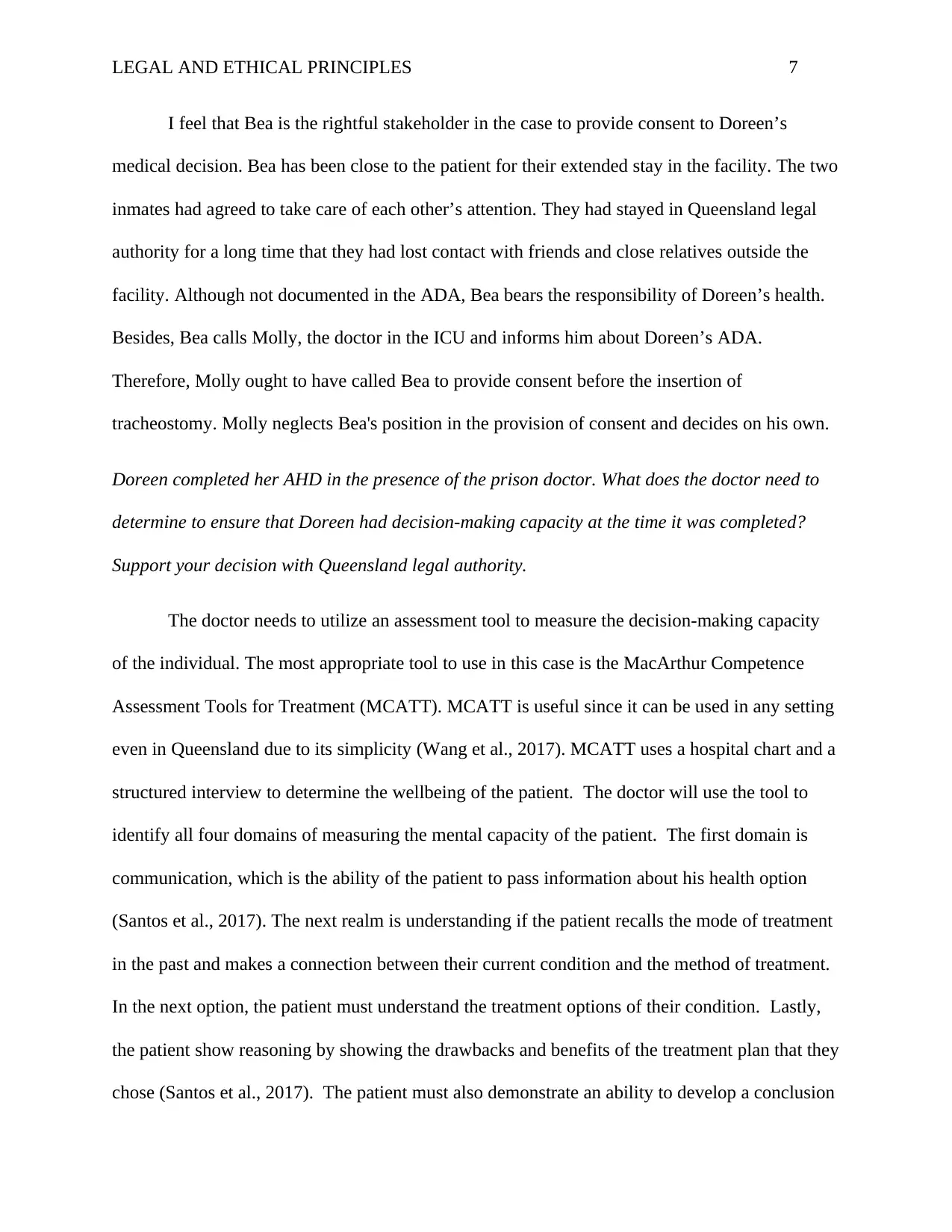
LEGAL AND ETHICAL PRINCIPLES 7
I feel that Bea is the rightful stakeholder in the case to provide consent to Doreen’s
medical decision. Bea has been close to the patient for their extended stay in the facility. The two
inmates had agreed to take care of each other’s attention. They had stayed in Queensland legal
authority for a long time that they had lost contact with friends and close relatives outside the
facility. Although not documented in the ADA, Bea bears the responsibility of Doreen’s health.
Besides, Bea calls Molly, the doctor in the ICU and informs him about Doreen’s ADA.
Therefore, Molly ought to have called Bea to provide consent before the insertion of
tracheostomy. Molly neglects Bea's position in the provision of consent and decides on his own.
Doreen completed her AHD in the presence of the prison doctor. What does the doctor need to
determine to ensure that Doreen had decision-making capacity at the time it was completed?
Support your decision with Queensland legal authority.
The doctor needs to utilize an assessment tool to measure the decision-making capacity
of the individual. The most appropriate tool to use in this case is the MacArthur Competence
Assessment Tools for Treatment (MCATT). MCATT is useful since it can be used in any setting
even in Queensland due to its simplicity (Wang et al., 2017). MCATT uses a hospital chart and a
structured interview to determine the wellbeing of the patient. The doctor will use the tool to
identify all four domains of measuring the mental capacity of the patient. The first domain is
communication, which is the ability of the patient to pass information about his health option
(Santos et al., 2017). The next realm is understanding if the patient recalls the mode of treatment
in the past and makes a connection between their current condition and the method of treatment.
In the next option, the patient must understand the treatment options of their condition. Lastly,
the patient show reasoning by showing the drawbacks and benefits of the treatment plan that they
chose (Santos et al., 2017). The patient must also demonstrate an ability to develop a conclusion
I feel that Bea is the rightful stakeholder in the case to provide consent to Doreen’s
medical decision. Bea has been close to the patient for their extended stay in the facility. The two
inmates had agreed to take care of each other’s attention. They had stayed in Queensland legal
authority for a long time that they had lost contact with friends and close relatives outside the
facility. Although not documented in the ADA, Bea bears the responsibility of Doreen’s health.
Besides, Bea calls Molly, the doctor in the ICU and informs him about Doreen’s ADA.
Therefore, Molly ought to have called Bea to provide consent before the insertion of
tracheostomy. Molly neglects Bea's position in the provision of consent and decides on his own.
Doreen completed her AHD in the presence of the prison doctor. What does the doctor need to
determine to ensure that Doreen had decision-making capacity at the time it was completed?
Support your decision with Queensland legal authority.
The doctor needs to utilize an assessment tool to measure the decision-making capacity
of the individual. The most appropriate tool to use in this case is the MacArthur Competence
Assessment Tools for Treatment (MCATT). MCATT is useful since it can be used in any setting
even in Queensland due to its simplicity (Wang et al., 2017). MCATT uses a hospital chart and a
structured interview to determine the wellbeing of the patient. The doctor will use the tool to
identify all four domains of measuring the mental capacity of the patient. The first domain is
communication, which is the ability of the patient to pass information about his health option
(Santos et al., 2017). The next realm is understanding if the patient recalls the mode of treatment
in the past and makes a connection between their current condition and the method of treatment.
In the next option, the patient must understand the treatment options of their condition. Lastly,
the patient show reasoning by showing the drawbacks and benefits of the treatment plan that they
chose (Santos et al., 2017). The patient must also demonstrate an ability to develop a conclusion
Paraphrase This Document
Need a fresh take? Get an instant paraphrase of this document with our AI Paraphraser
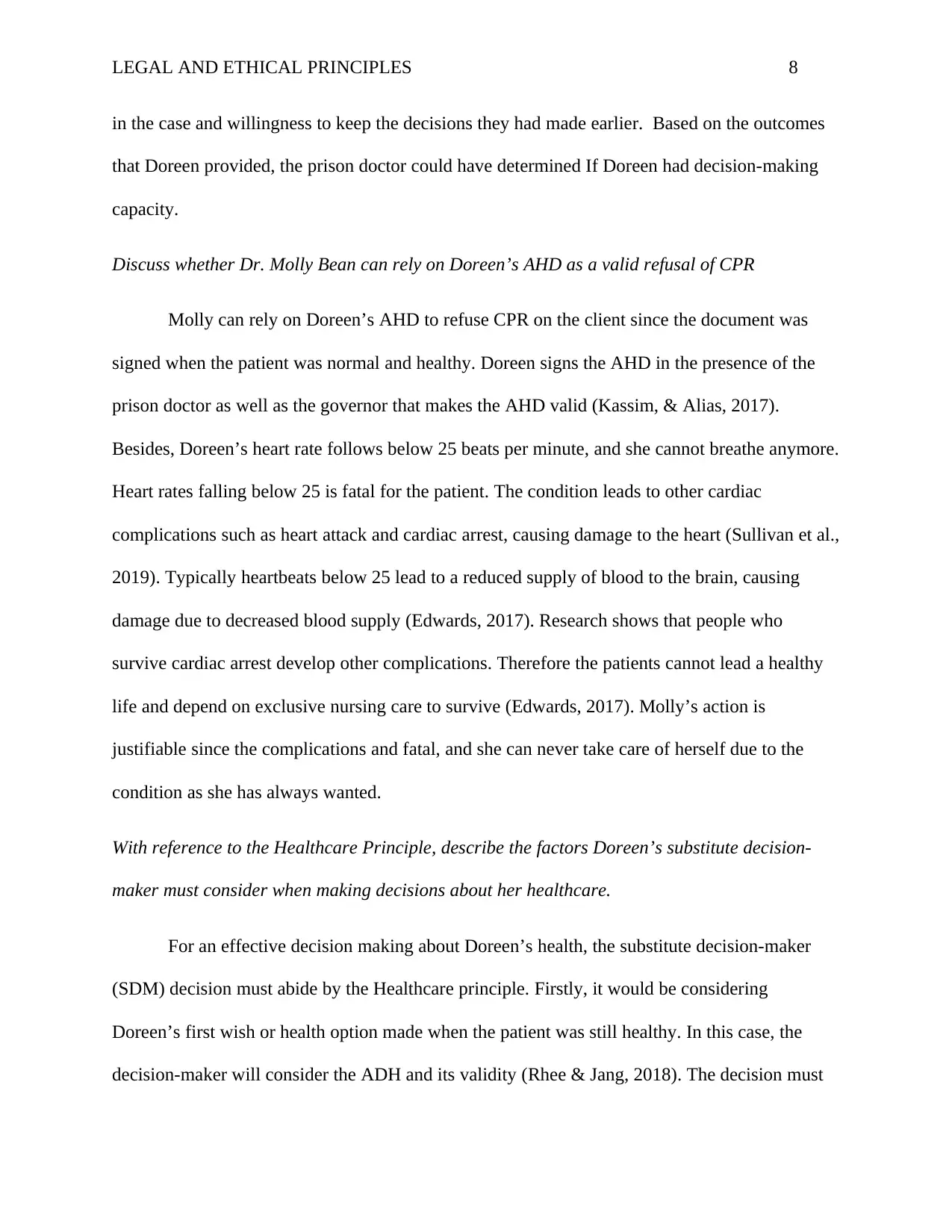
LEGAL AND ETHICAL PRINCIPLES 8
in the case and willingness to keep the decisions they had made earlier. Based on the outcomes
that Doreen provided, the prison doctor could have determined If Doreen had decision-making
capacity.
Discuss whether Dr. Molly Bean can rely on Doreen’s AHD as a valid refusal of CPR
Molly can rely on Doreen’s AHD to refuse CPR on the client since the document was
signed when the patient was normal and healthy. Doreen signs the AHD in the presence of the
prison doctor as well as the governor that makes the AHD valid (Kassim, & Alias, 2017).
Besides, Doreen’s heart rate follows below 25 beats per minute, and she cannot breathe anymore.
Heart rates falling below 25 is fatal for the patient. The condition leads to other cardiac
complications such as heart attack and cardiac arrest, causing damage to the heart (Sullivan et al.,
2019). Typically heartbeats below 25 lead to a reduced supply of blood to the brain, causing
damage due to decreased blood supply (Edwards, 2017). Research shows that people who
survive cardiac arrest develop other complications. Therefore the patients cannot lead a healthy
life and depend on exclusive nursing care to survive (Edwards, 2017). Molly’s action is
justifiable since the complications and fatal, and she can never take care of herself due to the
condition as she has always wanted.
With reference to the Healthcare Principle, describe the factors Doreen’s substitute decision-
maker must consider when making decisions about her healthcare.
For an effective decision making about Doreen’s health, the substitute decision-maker
(SDM) decision must abide by the Healthcare principle. Firstly, it would be considering
Doreen’s first wish or health option made when the patient was still healthy. In this case, the
decision-maker will consider the ADH and its validity (Rhee & Jang, 2018). The decision must
in the case and willingness to keep the decisions they had made earlier. Based on the outcomes
that Doreen provided, the prison doctor could have determined If Doreen had decision-making
capacity.
Discuss whether Dr. Molly Bean can rely on Doreen’s AHD as a valid refusal of CPR
Molly can rely on Doreen’s AHD to refuse CPR on the client since the document was
signed when the patient was normal and healthy. Doreen signs the AHD in the presence of the
prison doctor as well as the governor that makes the AHD valid (Kassim, & Alias, 2017).
Besides, Doreen’s heart rate follows below 25 beats per minute, and she cannot breathe anymore.
Heart rates falling below 25 is fatal for the patient. The condition leads to other cardiac
complications such as heart attack and cardiac arrest, causing damage to the heart (Sullivan et al.,
2019). Typically heartbeats below 25 lead to a reduced supply of blood to the brain, causing
damage due to decreased blood supply (Edwards, 2017). Research shows that people who
survive cardiac arrest develop other complications. Therefore the patients cannot lead a healthy
life and depend on exclusive nursing care to survive (Edwards, 2017). Molly’s action is
justifiable since the complications and fatal, and she can never take care of herself due to the
condition as she has always wanted.
With reference to the Healthcare Principle, describe the factors Doreen’s substitute decision-
maker must consider when making decisions about her healthcare.
For an effective decision making about Doreen’s health, the substitute decision-maker
(SDM) decision must abide by the Healthcare principle. Firstly, it would be considering
Doreen’s first wish or health option made when the patient was still healthy. In this case, the
decision-maker will consider the ADH and its validity (Rhee & Jang, 2018). The decision must

LEGAL AND ETHICAL PRINCIPLES 9
understand that Doreen would prefer to die other than being kept alive if she cannot support their
health.
Next is considering what would happen without medical intervention. The decision-
maker ought to ask themselves if the withdrawal of the treatment would increase, lower or not
affect the quality of life that the patient is living. The decision-maker must question if the
benefits of the treatment would change the shortcomings of the patient. The SDM must also put
into consideration the values and beliefs of the patient. The factor requires that the person acting
as SDM must be a close companion, family or a friend (Wong et al., 2019). In case of an
Attorney or an appointee, the person must dig some information about the patient. Lastly, the
SDM evaluates if there is a better action that is better than the proposed mode of treatment. The
SDM, then settles for the weightiest option (White et al., 2019). However, the government
directives suggests that the patient’s wish rule all the time.
Conclusion
In summation, the paper explores legal issues of an inmate diagnosed with diabetes. The
patient leaves an AHD to be used when he cannot take care of herself in case of disease
advancement. Throughout the text, various medical practitioners do not observe ethics and legal
requirements in healthcare. The case is just an example of many cases that medical practitioners
fail to observe legal and ethical principles during practice.
understand that Doreen would prefer to die other than being kept alive if she cannot support their
health.
Next is considering what would happen without medical intervention. The decision-
maker ought to ask themselves if the withdrawal of the treatment would increase, lower or not
affect the quality of life that the patient is living. The decision-maker must question if the
benefits of the treatment would change the shortcomings of the patient. The SDM must also put
into consideration the values and beliefs of the patient. The factor requires that the person acting
as SDM must be a close companion, family or a friend (Wong et al., 2019). In case of an
Attorney or an appointee, the person must dig some information about the patient. Lastly, the
SDM evaluates if there is a better action that is better than the proposed mode of treatment. The
SDM, then settles for the weightiest option (White et al., 2019). However, the government
directives suggests that the patient’s wish rule all the time.
Conclusion
In summation, the paper explores legal issues of an inmate diagnosed with diabetes. The
patient leaves an AHD to be used when he cannot take care of herself in case of disease
advancement. Throughout the text, various medical practitioners do not observe ethics and legal
requirements in healthcare. The case is just an example of many cases that medical practitioners
fail to observe legal and ethical principles during practice.
⊘ This is a preview!⊘
Do you want full access?
Subscribe today to unlock all pages.

Trusted by 1+ million students worldwide
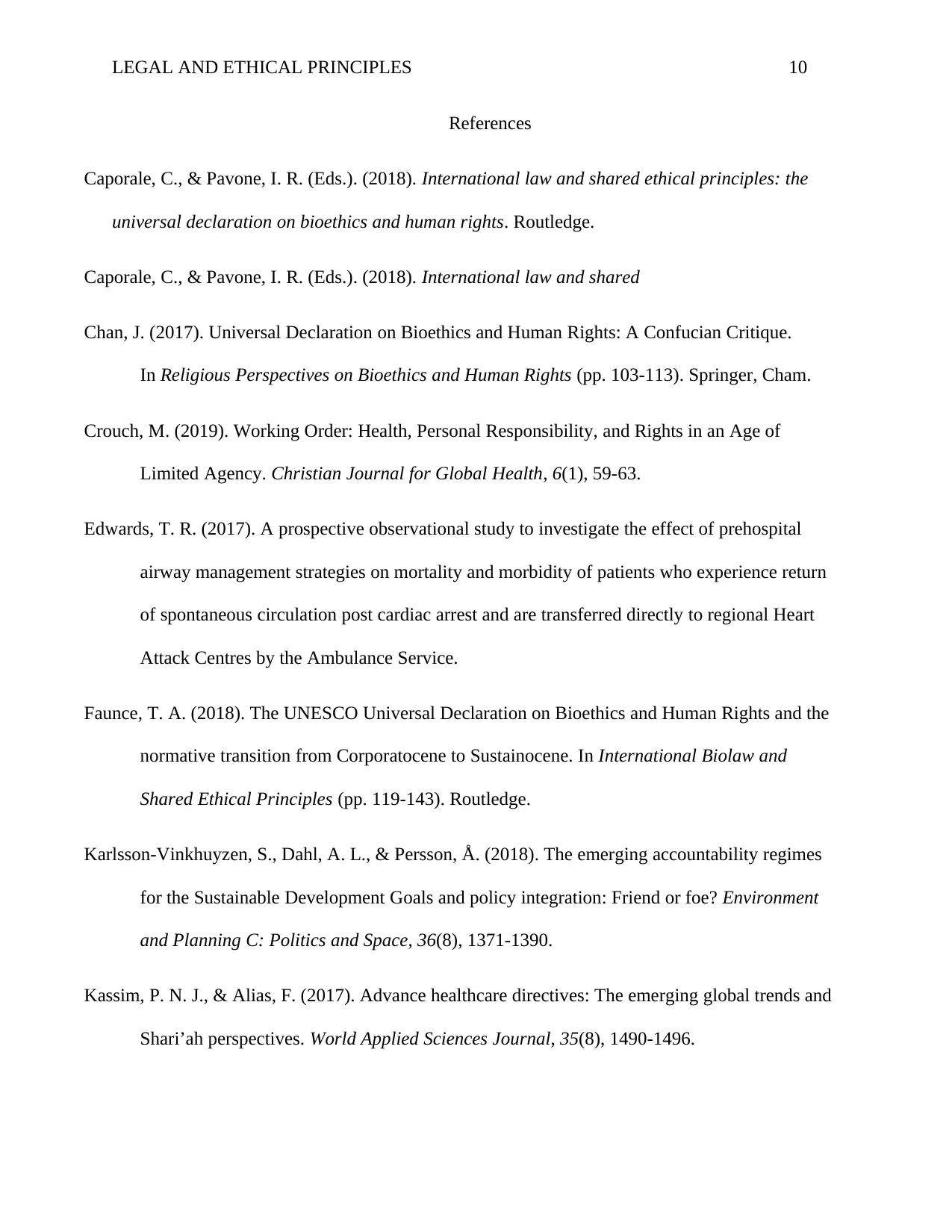
LEGAL AND ETHICAL PRINCIPLES 10
References
Caporale, C., & Pavone, I. R. (Eds.). (2018). International law and shared ethical principles: the
universal declaration on bioethics and human rights. Routledge.
Caporale, C., & Pavone, I. R. (Eds.). (2018). International law and shared
Chan, J. (2017). Universal Declaration on Bioethics and Human Rights: A Confucian Critique.
In Religious Perspectives on Bioethics and Human Rights (pp. 103-113). Springer, Cham.
Crouch, M. (2019). Working Order: Health, Personal Responsibility, and Rights in an Age of
Limited Agency. Christian Journal for Global Health, 6(1), 59-63.
Edwards, T. R. (2017). A prospective observational study to investigate the effect of prehospital
airway management strategies on mortality and morbidity of patients who experience return
of spontaneous circulation post cardiac arrest and are transferred directly to regional Heart
Attack Centres by the Ambulance Service.
Faunce, T. A. (2018). The UNESCO Universal Declaration on Bioethics and Human Rights and the
normative transition from Corporatocene to Sustainocene. In International Biolaw and
Shared Ethical Principles (pp. 119-143). Routledge.
Karlsson-Vinkhuyzen, S., Dahl, A. L., & Persson, Å. (2018). The emerging accountability regimes
for the Sustainable Development Goals and policy integration: Friend or foe? Environment
and Planning C: Politics and Space, 36(8), 1371-1390.
Kassim, P. N. J., & Alias, F. (2017). Advance healthcare directives: The emerging global trends and
Shari’ah perspectives. World Applied Sciences Journal, 35(8), 1490-1496.
References
Caporale, C., & Pavone, I. R. (Eds.). (2018). International law and shared ethical principles: the
universal declaration on bioethics and human rights. Routledge.
Caporale, C., & Pavone, I. R. (Eds.). (2018). International law and shared
Chan, J. (2017). Universal Declaration on Bioethics and Human Rights: A Confucian Critique.
In Religious Perspectives on Bioethics and Human Rights (pp. 103-113). Springer, Cham.
Crouch, M. (2019). Working Order: Health, Personal Responsibility, and Rights in an Age of
Limited Agency. Christian Journal for Global Health, 6(1), 59-63.
Edwards, T. R. (2017). A prospective observational study to investigate the effect of prehospital
airway management strategies on mortality and morbidity of patients who experience return
of spontaneous circulation post cardiac arrest and are transferred directly to regional Heart
Attack Centres by the Ambulance Service.
Faunce, T. A. (2018). The UNESCO Universal Declaration on Bioethics and Human Rights and the
normative transition from Corporatocene to Sustainocene. In International Biolaw and
Shared Ethical Principles (pp. 119-143). Routledge.
Karlsson-Vinkhuyzen, S., Dahl, A. L., & Persson, Å. (2018). The emerging accountability regimes
for the Sustainable Development Goals and policy integration: Friend or foe? Environment
and Planning C: Politics and Space, 36(8), 1371-1390.
Kassim, P. N. J., & Alias, F. (2017). Advance healthcare directives: The emerging global trends and
Shari’ah perspectives. World Applied Sciences Journal, 35(8), 1490-1496.
Paraphrase This Document
Need a fresh take? Get an instant paraphrase of this document with our AI Paraphraser

LEGAL AND ETHICAL PRINCIPLES 11
Lamont, S., Stewart, C., & Chiarella, M. (2019). Capacity and consent: knowledge and practice of
legal and healthcare standards. Nursing ethics, 26(1), 71-83.
Lamont, S., Stewart, C., & Chiarella, M. (2019). Capacity and consent: knowledge and practice of
legal and healthcare standards. Nursing ethics, 26(1), 71-83.
Méndez, J. E. (2017). Accountability for past abuses. In Genocide and Human Rights (pp. 429-456).
Routledge.
Rhee, M. K., & Jang, Y. (2019). Factors Associated With Designation of a Substitute Decision-
Maker in Older Asian Americans: The Role of Cultural Factors. The International Journal of
Aging and Human Development, 0091415019848211.
Wong, M. K., Medor, M. C., Labre, K. Y., Jiang, M., Frank, J. R., Fischer, L. M., & Cheung,
W. J. (2019). Gaps in public preparedness to be a substitute decision-maker and the
acceptability of high school education on resuscitation and end-of-life care: a mixed-methods
study. CMAJ open, 7(3), E573.
Santos, R. L., Sousa, M. F. B. D., Simões Neto, J. P., Bertrand, E., Mograbi, D. C., Landeira-
Fernandez, J., ... & Dourado, M. C. N. (2017). MacArthur Competence Assessment Tool for
Treatment na doença de Alzheimer: adaptação transcultural. Arquivos de Neuro-
Psiquiatria, 75(1), 36-43.
Savulescu, J. (2018). Golden opportunity, reasonable risk and personal responsibility for
health. Journal of medical ethics, 44(1), 59-61.
Sullivan, W. F., Heng, J., McNeil, K., Bach, M., Henze, M., Perry, A., & Vogt, J. (2019). Promoting
health care decision-making capabilities of adults with intellectual and developmental
disabilities. Canadian Family Physician, 65(Suppl 1), S27.
Lamont, S., Stewart, C., & Chiarella, M. (2019). Capacity and consent: knowledge and practice of
legal and healthcare standards. Nursing ethics, 26(1), 71-83.
Lamont, S., Stewart, C., & Chiarella, M. (2019). Capacity and consent: knowledge and practice of
legal and healthcare standards. Nursing ethics, 26(1), 71-83.
Méndez, J. E. (2017). Accountability for past abuses. In Genocide and Human Rights (pp. 429-456).
Routledge.
Rhee, M. K., & Jang, Y. (2019). Factors Associated With Designation of a Substitute Decision-
Maker in Older Asian Americans: The Role of Cultural Factors. The International Journal of
Aging and Human Development, 0091415019848211.
Wong, M. K., Medor, M. C., Labre, K. Y., Jiang, M., Frank, J. R., Fischer, L. M., & Cheung,
W. J. (2019). Gaps in public preparedness to be a substitute decision-maker and the
acceptability of high school education on resuscitation and end-of-life care: a mixed-methods
study. CMAJ open, 7(3), E573.
Santos, R. L., Sousa, M. F. B. D., Simões Neto, J. P., Bertrand, E., Mograbi, D. C., Landeira-
Fernandez, J., ... & Dourado, M. C. N. (2017). MacArthur Competence Assessment Tool for
Treatment na doença de Alzheimer: adaptação transcultural. Arquivos de Neuro-
Psiquiatria, 75(1), 36-43.
Savulescu, J. (2018). Golden opportunity, reasonable risk and personal responsibility for
health. Journal of medical ethics, 44(1), 59-61.
Sullivan, W. F., Heng, J., McNeil, K., Bach, M., Henze, M., Perry, A., & Vogt, J. (2019). Promoting
health care decision-making capabilities of adults with intellectual and developmental
disabilities. Canadian Family Physician, 65(Suppl 1), S27.

LEGAL AND ETHICAL PRINCIPLES 12
Wang, S. B., Wang, Y. Y., Ungvari, G. S., Ng, C. H., Wu, R. R., Wang, J., & Xiang, Y. T. (2017).
The MacArthur Competence Assessment Tools for assessing decision-making capacity in
schizophrenia: a meta-analysis. Schizophrenia research, 183, 56-63.
White, B., Then, S. N., & Willmott, L. (2018). Adults who lack capacity: Substitute decision-
making. Health Law in Australia (Third Edition). Thomson Reuters, Pyrmont, New South
Wales, 207-270.
Wang, S. B., Wang, Y. Y., Ungvari, G. S., Ng, C. H., Wu, R. R., Wang, J., & Xiang, Y. T. (2017).
The MacArthur Competence Assessment Tools for assessing decision-making capacity in
schizophrenia: a meta-analysis. Schizophrenia research, 183, 56-63.
White, B., Then, S. N., & Willmott, L. (2018). Adults who lack capacity: Substitute decision-
making. Health Law in Australia (Third Edition). Thomson Reuters, Pyrmont, New South
Wales, 207-270.
⊘ This is a preview!⊘
Do you want full access?
Subscribe today to unlock all pages.

Trusted by 1+ million students worldwide
1 out of 12
Related Documents
Your All-in-One AI-Powered Toolkit for Academic Success.
+13062052269
info@desklib.com
Available 24*7 on WhatsApp / Email
![[object Object]](/_next/static/media/star-bottom.7253800d.svg)
Unlock your academic potential
Copyright © 2020–2025 A2Z Services. All Rights Reserved. Developed and managed by ZUCOL.





